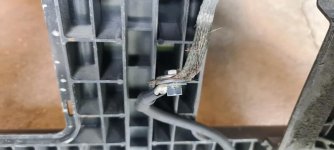Actually, No it won't - that's because even though the air compressor is not operating, the sensor and the vent valve still are. So, every time you go over a bump, bridge, etc, and the rear suspension moves up and down, the vent valve will let the air out. Without a compressor to refill the air, all of the air will be gone in a matter of minutes.
So, Norwegian, you're kind of in limbo right now. First check for leakage. Tonight, use the valve under the seat and put between 50 and 60 pounds of air in it. Just let it sit overnight, and check the pressure in the morning. Remembering that you'll lose about 2 pounds every time you check it, and remember that it is probably cooler in the morning, see how much pressure you have left. If it held pressure, then you can take these two quick steps:
- Go into your fuse box and remove the suspension relay - R1.
- Remove the right side panels and find the vent valve mounted to the right side framework. It's got all of the air tubing going to it. Follow the wire harness leaving the valve and unplug it at the connector. The connector is probably behind the framework kind of hidden. Seal up the wire harness from moisture where you unplugged it.
Now you can run the system manually by adding air under the seat and it will stay at pressure.
On the other hand, if you have a leak and all of your air pressure is gone the next morning, you are kind of stuck. There's no way to keep air in the system. The two most common places for leakage on the 2012 is at the compressor check valve, and at a swiveling elbow joint on the vent valve. And yes, sometimes at the top airbag fitting. But, while you are looking at the vent valve with all of those panels off, you will see that an interim and alternative fix is relatively easy.
Disconnect the tubing coming from the air bag and the valve under the seat from the vent valve. They are push-to-connect fittings, so you release them the standard way for those fittings. It takes a few tries. Purchase an in-line tubing coupling and connect the two ends together. Make sure it is rated for those high pressures. Don't use a cheap plastic one. Now, all you have is a straight line of tubing from the valve under the seat directly to the air bag. Do another leak test over night. I bet it holds air this time. If it does, remove relay R1 and unplug the vent valve if not already done before. Now you can ride for the rest of the season. And, there's a high probability that you'll like it better and just keep it that way for good.

